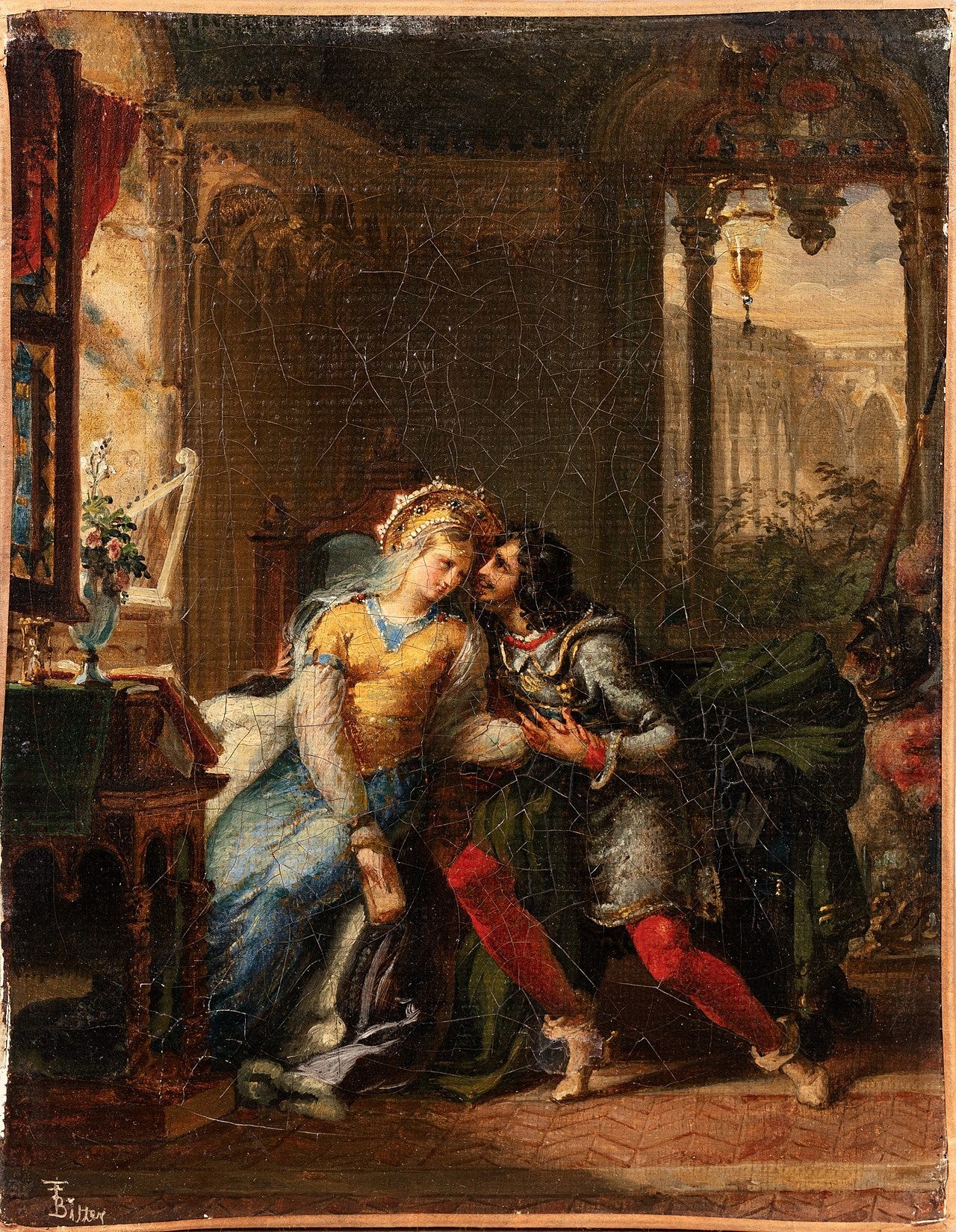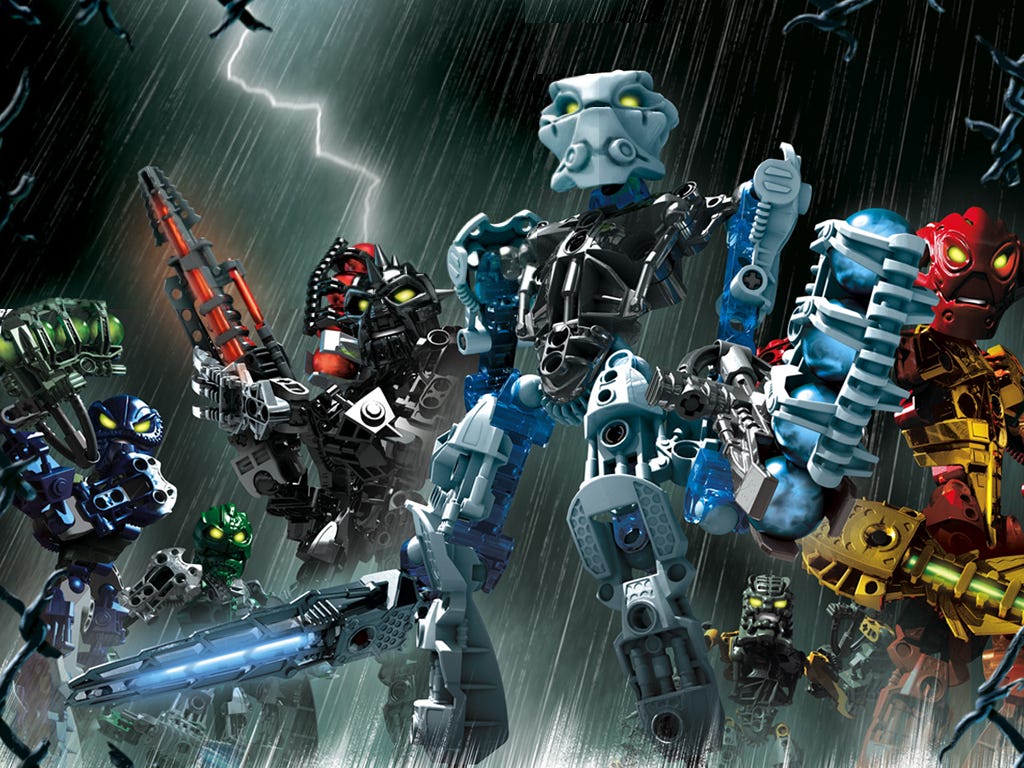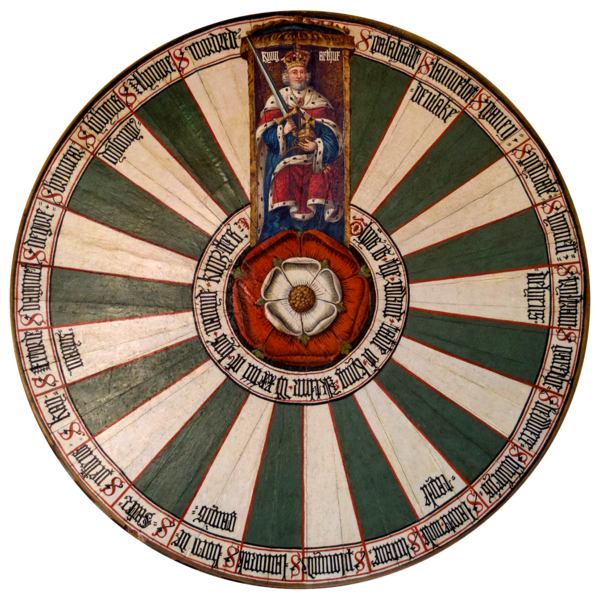Time before Time: Bionicle's Toa & King Arthur's Roundtable
We're back valorizing Danish pieces of plastic
Dear readers,
God, where the holy halibut have the last six weeks gone? Beyond just trying to survive in the hellscape, I did manage to start and finish some things — finished my second poetry manuscript, sent it out to publishers, and finished another draft of my dissertation prospectus. I also started recording an album and put out some feelers for a Chaucer themed podcast. ADHD goes brrrrrr…
However, I promised my readers more on Bionicle and the medieval, and I will not fail to deliver:
The extended Arthurian universe did not come together all at once in a quick swoop of marketing efforts from a Danish corporation, but its composition and evolution does bear some resemblances to the Bionicle universe from the start. Both universes ‘exist’ in temporalities hard to reconcile with the linear, historical time but not for lack of trying. The oft quoted “in a time before a time”with fans since the series’ inception in 2001 wraps up the explanation of the Bionicle universe nicely — it was in a time before our time now — don’t worry about it! Just buy the toys. “The Legend of Mata Nui” told again and again in Bionicle media across the comic, novel adaptations, and films generally start as “the booke tellyth” in Hapka’s Tale of the Toa (also featured in the last Substack on this):
“In the time before time, the Great Spirit descended from the heavens, carrying we, the ones called the Matoran, to this island paradise. We were separate and without purpose, so the Great Spirit blessed us with three virtues: unity, duty, and destiny. We embraced these gifts and, in gratitude, we named our island home Mata Nui, after the Great Spirit himself.”
Tale of the Toa, Hapka, 1
Embedded is also a creation story, which is not necessarily always apart of Arthurian cycles, or narrative/story patterns. This is one of the stark contrasts between Bionicle and Arthur — the Arthurian traditions usually tries to situate the events of the given cycle within the scope of human history rather than outside of it. As where/when that starts there is some variation. The Trojan cycle is often not far. Compare some opening excerpts from Geoffrey of Monmouth’s History of the Kings of Britain (c. 1136; Giles translation) and Sir Gawain & the Green Knight (c. 1375-1400; translation mine):
[Britain] is lastly inhabited by five different nations, the Britons, Romans, Saxons, Picts, and Scots; whereof the Britons before the rest did formerly possess the whole island from sea to sea, till divine vengeance, punishing them for their pride, made them give way to the Picts and Saxons. But in what manner, and from whence, they first arrived here, remains now to be related in what follows […] After the Trojan war, Æneas, flying with Ascanius from the destruction of their city, sailed to Italy. There he was honourably received by king Latinus, which raised against him the envy of Turnus, king of the Rutuli, who thereupon made war against him.
Book I, Chapters II-III, Monmouth’s HKB
SIÞEN þe sege and þe assaut watz sesed at Troye, Þe borȝ brittened and brent to brondeȝ and askez, Þe tulk þat þe trammes of tresoun þer wroȝt Watz tried for his tricherie, þe trewest on erþe: Hit watz Ennias þe athel, and his highe kynde, Þat siþen depreced prouinces, and patrounes bicome Welneȝe of al þe wele in þe west iles. (SGGK, Fitt 1, lines 1-7)
Since the siege and assault [which] had seized Troy, the borough brittled and burnt to brand and ashes, the warrior that wrought the training of treason was tried for his treachery -- the truest on earth: He was called Æneas the great, and his high kind, that since have divided provinces, and become patrons well neigh of the all that well/wealth in the western isles [Britain]. (translation mine)
Both of these texts ground the larger Trojan narrative (Odyssey, Iliad, Æneid) as the start of their contribution to the Arthurian universe. Both are also very different texts — Monmouth’s HKB a 12th century prose ‘chronicle’ with a definite audience and patron. SGGK on the other hand is a poem written more than two hundred years later by fairly well known anonymous author (usually referred to as the ‘Gawain’ or ‘Pearl Poet’). In other words, both authors seek to put these texts in conversations with legendary history in ‘our world’ — albeit a very facetious version informed by Norman/Angevin cultural and dynastic pride. Meanwhile, LEGO just wanted to sell cool and sick toys about "biological chronicles”.
The Arthurian universe and Bionicle both have generations of heroes with some idea of genealogy connecting them to each other — and both universes struggle to talk about sexuality directly (ie, procreation). While Bionicle is essentially sexless, Camelot (Arthur’s court) does not always deal with sexuality directly. Much sexual tension is transmuted through the ideals of courtly love — the collection of largely literary ideas about love and romance which began to circulate throughout medieval Europe. Oftentimes, chivalry and nobility motivated this kind of “love”; the epitome being a knight serving his lady (regardless if she’s married or not) and performing deeds on behalf of their “love” for her. Talk about being a professional simp… so instead of addressing the sexual desire directly, we’re all supposed to act surprised when Sir Lancelot and Queen Guinevere shack up at the end of Malory’s Le Morte d’Arthur.

Some significant (and overlapping) courts in the Arthurian aside from Arthur’s Round Table include the courts of King Mark, Caerleon, Roman emperors, and various Saxon tribes. Some of these courts will invariably marry into, split, or (try to) conquer the power of the House of Constantine — the dynasty whom Arthur belongs to. Bionicle generally delineates between generations of heroes more clearly, but the timeline of the universe is just as confusing in the twists and turns it makes. The “Toa Teams” are more akin to generations of Power Rangers teams — another pop culture franchise I should explore here sometime!
In general there are three major Toa Teams:
Toa Mata/Toa Nuva (left to right)
Onua - Toa Mata/Nuva of Earth
Lewa - Toa Mata/Nuva of Air
Pohatu - Toa Mata/Nuva of Stone
Tahu - Toa Mata/Nuva of Fire
Kopaka - Toa Mata/Nuva of Ice
Gali - Toa Mata/Nuva of Water

Promotional image of Toa Mata team, c. 2001. Copyright LEGO; qualifies as fair use under United States copyright law.

Promotional image of Toa Nuva team, c. 2003 Copyright LEGO; qualifies as fair use under United States copyright law Toa Metru/Toa Hordika (who later become the elders of Mata Nui, ‘Turaga’; left to right:)
Whenua - Toa Metru/Hordika of Earth
Nokama - Toa Metru/Hordika of Water
Vakama - Toa Metru/Hordika of Fire
Matau - Toa Metru/Hordika of Air
Nuju - Toa Metru/Hordika of Ice
Onewa - Toa Metru/Hordika of Stone

Promotional image of Toa Nuva team, c. 2004 Copyright LEGO; qualifies as fair use under United States copyright law. 
Promotional image of Toa Hordika sets, c. 2005 Copyright LEGO; qualifies as fair use under United States copyright law; images compiled by me. 
Bonus: the Toa Metru as Turaga (retirees). First row left to right Nuju, Vakama, Nokama, second row left to right Onewa, Whenua, Matau., c. 2001. Copyright LEGO; qualifies as fair use under United States copyright law. Toa Inika/Toa Mahri
Hahli - Toa Inika/Mahri of Water
Kongu - Toa Inika/Mahri of Air
Nuparu - Toa Inika/Mahri of Earth
Matoro - Toa Inika/Mahri of Ice
Hewkii - Toa Inika/Mahri of Stone
Jaller - Toa Inika/Mahri of Fire


Within various good versus evil narratives (ie Mata Nui versus Makuta), these Toa Teams will start teleologically at one point — like the Toa Mata, and undergo some kind of fundamental transformation the next fiscal year for LEGO. The Toa Mata are transformed into the shiny Toa Nova after encountering the “Energized Protodermis” (need me some of that), the Toa Metru became infected by Hordika Venom and then into the more bestial Toa Hordika (eventually cured), and the Toa Inika became Mahri through…well I started to lose track of Bionicle by that point. But sources indicate that 100,000 years prior to the event of the Toa Mahri’s arc, the Ignika Kanohi (ie, the masks where they draw their power and life force from) was created for the creator deity Mata Nui himself. Lost and refound over the ages, eventually Matoro encounters it and it transforms all the Toa Inika’s waterbreathing, more fit for aquatics form: Toa Mahri. It’s worth mentioning for context that Mahri Nui is underwater and well, you wouldn’t go underwater hundreds of leagues without transforming into a more evolved version of yourselves, would you? During the course of writing out this insane timeline, I realized that the Toa Mata, Toa Metru, and Toa Inika follow a similar structure to the Star Wars trilogies: the “originals”, the “prequels”, and the “sequels”. There are other more obscure Toa Teams as well — but I think that’s for another Substack.
On the Arthurian side of things, the generations of knights center around the Round Table. In Book III of Le Morte d’Arthur, King Leodegrance of Cameliard gives the Round Table and hundred of his knights to King Arthur as an upstart king with a few battles under his belt as King. It was a gift to Leodogrance from Arthur’s father, Uther Pendragon. Oh, and his daughter Guinevere’s hand in marriage — what a dowry! Leodegrance insists that the Round Table is complete with one hundred and fifty knights, the last fifty steadily populated with knights like Gawain and Lancelot as Le Morte d’Arthur goes on. Did I mention it’s almost one thousand pages long? Some knights are older, others younger, some brothers, some enemies, some brothers and enemies both! Like any good franchise though, the fall of the Round Table does come about in the civil war brought on by the ascent of Mordred and Lancelot’s affair with Guinevere. Messy times!
The raison d’être for the Toa Teams and the Table Round are specific goals. The Round Table exists in part to find the Holy Grail — though only three will end up being pure enough to see it: Sir Galahad (Lancelot’s illegitimate son), Sir Bors, and Sir Percival. Each Toa Team has a unique ontological goal each, revolving around the restoring of their realm to some more idyllic time. The Toa Mata for example, come to awaken Mata Nui from his slumber as Makuta put him to ‘sleep’ and subsequently took over the island Mata Nui. For the Toa Metru, their goal to save the Mataron from the Great Cataclysm caused by Teridex — an event akin to the Fall as depicted by Miltonian tradition of original sin. The Toa Teams — even if they take a few millennia — generally seem to get their goals done together as ‘all for one, one for all’. In contrast, the Round Table is more prone to infighting and falling short of what they set out to do. But it’s also hard to make broad statements about the Arthurian universe because there’s so many sources across the last thousand years which don’t always talk to one another. In this Substack, I’ve tried to stay within two influential English sources — Geoffrey of Monmouth’s History of the Kings of Britain and Sir Thomas Malory’s Le Morte d’Arthur, written more than 300 years apart from one another.
Hope that illuminates a bit more of my cross-pop-cultural work on Bionicle! More to come in the new year.




